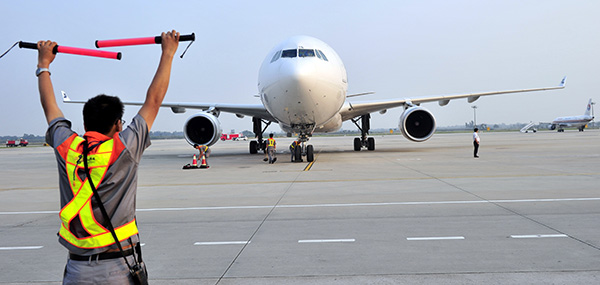A passenger jetliner at Xianyang International Airport in Xi'an, Shaanxi province. China built 15 new airports and expanded 28 existing ones in provinces involved in the Belt and Road Initiative in the past two years. [Photo/China Daily]
Civil aviation projects to increase regional connectivity with investment of $32b

About 200 billion yuan ($32 billion) will be spent to develop civil aviation projects linked to the Belt and Road Initiative.
"At the start of this year, we began to implement 51 important projects that are closely related to the Belt and Road Initiative, with an estimated cost of 200 billion yuan," Li Jiaxiang, director of the Civil Aviation Administration of China, said at the 2015 China Civil Aviation Development Forum that opened on Wednesday in Beijing.
More than 400 government officials, international organization representatives, industry leaders and experts from 24 nations and regions are taking part in the two-day meeting.
China built 15 new airports and expanded 28 existing ones in provinces involved in the initiative during the past two years, he noted. A total of 4.7 billion yuan was allocated to these provinces over the same period to upgrade air traffic control installations and equipment, he said.
The Belt and Road Initiative, a development strategy proposed by President Xi Jinping in 2013, refers to the Silk Road Economic Belt, which will link China with Europe via Central and Western Asia, and the 21st Century Maritime Silk Road, which stretches from southern China to Southeast Asia, South Asia, Africa and Europe.
The ambitious initiative is expected to benefit about 4.4 billion people in 65 countries.
Countries within the scope of the initiative have an aggregate GDP of $21 trillion, accounting for 29 percent of the world's total. In 2014, China's total trade with these nations and regions reached $1.12 trillion, roughly 25 percent of the country's overall global trade that year, Li said.
He forecast that figure would double within the coming decade.
Twenty-four out of 83 new air routes planned to be opened this summer and autumn by Chinese airlines will link cities in China and areas covered by the initiative, including four countries that now have no air links with China, according to Li.
Air transportation has several advantages that can help speed up the formation of the Silk Road Economic Belt and 21st Century Maritime Silk Road. The necessary infrastructure can be built faster and at a lower cost than roads and railways, it is safer and faster, and it has a smaller impact on the environment, Li explained.
The CAAC has pledged to further open the country's airspace to carriers from Central and South Asia to allow for more direct air links.
China will also help countries along the trade routes train 500 civil aviation professionals in the coming five years, he added.
Wang Ya'nan, deputy editor-in-chief of Aerospace Knowledge magazine, said air transportation is the best way to improve connectivity among related nations and regions.
"Connectivity is no doubt the very foundation for trade, tourism as well as other forms of exchange. Many countries along the Belt and Road are closed off by mountains and deserts, making it difficult to build roads or railways within a short period of time. As a result, air transportation has huge potential in the initiative," he said.
Li Xiaoqun, a researcher at the Civil Aviation Management Institute of China, urged the civil aviation sector to seize the opportunities generated by the Belt and Road Initiative to expand their operations and networks worldwide.
